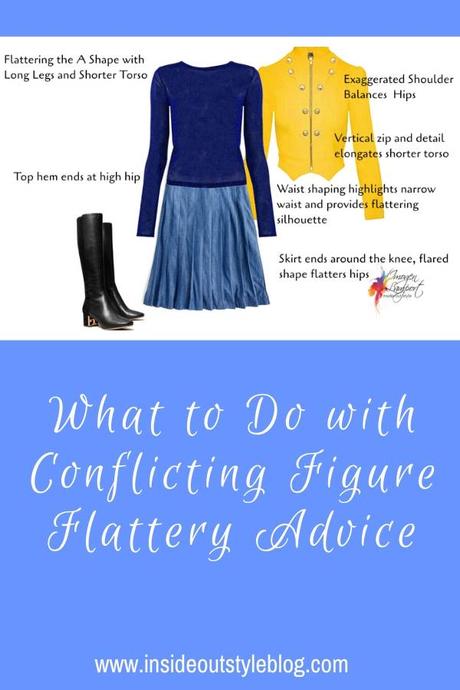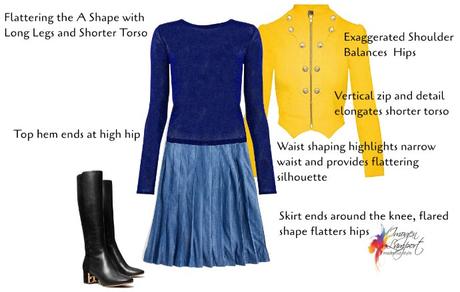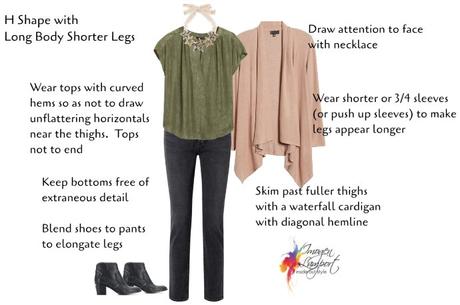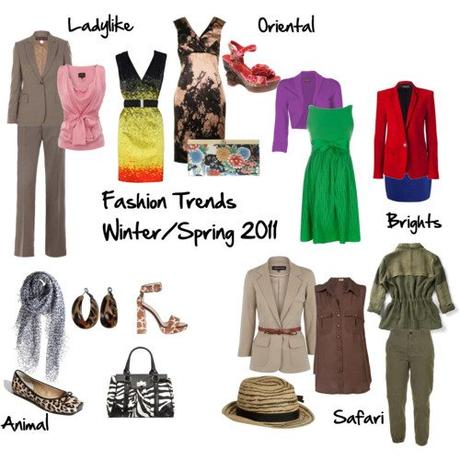Body shapes, body proportions, body variations. These all impact on what your individual figure flattery guidelines will be as each of the body shapes and body proportion guidelines are generic and don't take into consideration aspects of the other.
 What Does Body Shape Tell You?
What Does Body Shape Tell You?
- Where to put verticals to slim or elongate.
- Where to put horizontals to highlight, balance or broaden.
- Where to add detail to draw attention.
- The overall silhouette of flattering garments.
Body shape does NOT tell you how long your garments should be - where the hems are - this is part of body proportions
If you're not sure of your shape you can do my free body shape calculator quiz here or join up to my 7 Steps to Style program where you'll get all the information you need to dress your unique shape.
What Do Body Proportions Tell You?
- Where to end hems - sleeve hems, shirt hems, jacket hems, skirt hems, dress hems, pant hems.... all hems!
- Where to add detail
- Where to keep boring and plain - free of detail
Body proportions don't tell you what shape the best garments are for you.
What Do Body Variations Tell You
- If you need to add detail to emphasise or keep plain and boring an area you'd rather wasn't a focal point
- To use scale to make an area appear larger or smaller
- Some garment details
- May impact on body shape or body proportion rules (and create a need for tweaking for your unique features)
Body variations are what make your body unique.
Why Body Shape Advice that Includes Body Proportions and Variations All-In-One Doesn't Work
As much as there may be more common body shape, proportion and variations that may often go together, they are individual features and you are a unique being and so will always need to customise your figure flattery guidelines to work for you!
Body shapes tell you the overall silhouette of the garments, but not lengths. When you start adding those elements together, and then pile body variations on top, small bust, large bust, tall, petite, curved booty or flat booty etc.... these things are all variations that come on any body shape!
For example: you may often read that an A shape has a small bust. But not so - your bust size is a body variation, not part of your body shape.
An A shape may more commonly have a longer body and shorter legs, but this too may be reversed or you may be balanced, or have a short-mid body. This will depend on your height and other factors. This is why where to end hems is part of body proportions, not body shape advice.
So how to dress your body when you feel the advice is conflicting?
Choose What Matters Most to You
- What do you really want to highlight with a focal point?
- What do you really want to camouflage (if anything)?
- Where do you want to elongate or slim?
- Where do you want to balance or broaden?
Then look at all the advice and choose what matters to you most. Use all the guidelines to create your own figure flattery guidelines!
Creating Your Own Figure Flattery Guidelines
As I've written about in my Body Equation post, it's about sorting out what works for your individual body and your needs.
So for example, if I use the A shape with a short body and long legs
- I will want to use the body proportion guidelines for where to end skirt/dress hem lengths.
- I will choose to end sleeves based on the most flattering points of the arms (as I don't have to lengthen legs, I can then look at arm shape as a body variation and make a decision about ending the sleeve hem at narrow points on the arms.
- I will highlight a narrow waist, but may not want to use a wide belt to do this but instead use a narrow one (as the waist is shorter), or no belt, but just fit and flare shaped clothing (the silhouette advice for an A shape).
- With a shorter body I may want to use some verticals on the torso to elongate it and balance with the longer legs - so look for an open cardigan or jacket or choose shirts that button up, providing that vertical detail through the body.
- With a shorter body, I may not want to tuck in unless tucking and blousing so as not to further shorten the body. Instead, I will end tops at the hip bone.
- Choose a part of the body to create a focal point - with a shorter waisted A shape this may be the decolletage and to balance the hips I would look for horizontal details that are around the shoulders - such as boat neck, embellished shoulders, puffed or gathered sleeves, epaulettes etc.
- Keep those parts of the body that are shorter and you don't want to draw attention to plain and free of extraneous details - such as pockets on the thighs.

Another example could be an H shape with a long body and shorter legs and fuller thighs
- I will want to balance the H shape body proportionally with skirts/dress hems at the knee, no longer, but also not shorter than just at the top of the knee.
- I will want to draw the eye upwards so end sleeves at 3/4 length or shorter
- I will want to balance the body and legs, so no tunic-length tops unless they are belted with a curved hip belt which will give the illusion of some waist and also make the torso and legs more balanced.
- I will otherwise end tops at the hip bone or just below, curved hems on tops are the best option rather than straight ones.
- I will draw attention upwards to the bust and above with detail and embellishment
- I will keep the thighs free of detail such as pockets and distressing on jeans and instead look for vertical detail in dresses and skirts to elongate and slim them.
 When you add a body variation into the equation such as a large bust, this can visually shorten the waist ( which I've written about here) and change some of your figure flattery guidelines.
When you add a body variation into the equation such as a large bust, this can visually shorten the waist ( which I've written about here) and change some of your figure flattery guidelines.
More Tips on How to Flatter Your Unique Figure
Advancing and Receding with Colour and Creating Focal Points
How to Rock Patterns on Your Lower Half - X and A Shapes
How to Be a Style Magician
Brilliant Tricks of the Clothing Magician - How to Highlight and Camouflage for Figure Flattery


